|

by Ivan Petricevic
November 06,
2017
from
Ancient-Code Website

No matter where we look, cyclopean masonry megalithic sites, and
Pyramids are scattered across the entire planet.
It's as if thousands of
years ago, all of a sudden, different civilizations across the globe
decided to erect,
-
massive monuments
-
Pyramids
-
Temples
-
cyclopean walls,
...and the same process
is found on nearly all continents o Earth.
The similarities are
unlike anything ever seen before, and the information is absent from
history books.
From Mesopotamia to Mesoamerica, there's evidence of a so-called
'master builder.'
It cannot be a mere coincidence that thousands of years ago, nearly
ALL ancient cultures decided to build massive, temples,
massive pyramids and cyclopean walls that are so perfectly designed
and built, that not a single sheet of paper can fit between them.
In fact, these ancient
structures were so precise and so wee-built, that they have managed
to survive for thousands of years.
If we take a look at history, we will notice that for the past 5,000
to 8,000 years, ancient cultures around the globe experienced what I
call a
megalithic building era where
different civilization - that according to mainstream scholars were
never interconnected - started building similar structures
throughout the world.
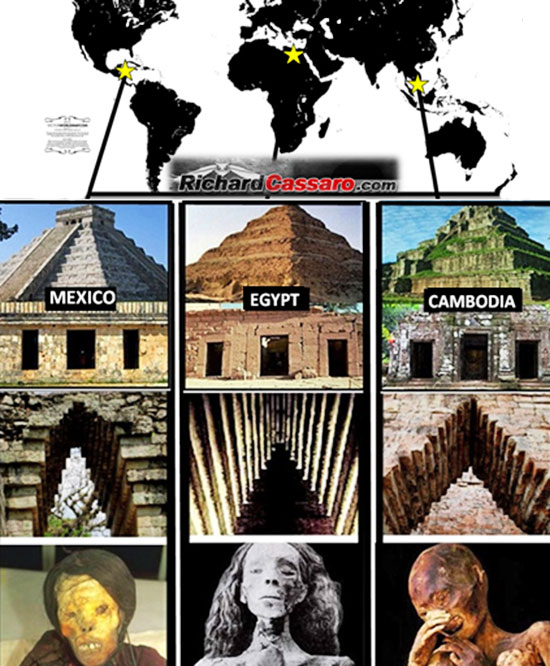
Image Credit:
Richard
Cassaro
It was as if a building plague had struck them, and they created
structures that repeat themselves over and over again in different
places and different times.
But, if there are so many similar structures around the globe,
If you research this
subject, you will notice that it's as if we are talking about the
'same architect' that seemed to have appeared on different
continents around the globe but in different times.
When you notice the fact that for thousands of years, mankind
erected nearly identical structures around the globe, then you
understand that there is a relationship among them.
Pyramids are just one of the many
examples of massive building projects that occurred on Earth
thousands of years ago. If you want evidence of a megalithic
building era in our civilization, then the best structures to look
at are Pyramids.
They are found
everywhere, in nearly every region of the world, including,
-
Central America
-
North America
-
Mesopotamia
-
Egypt
-
Asia
-
even Europe
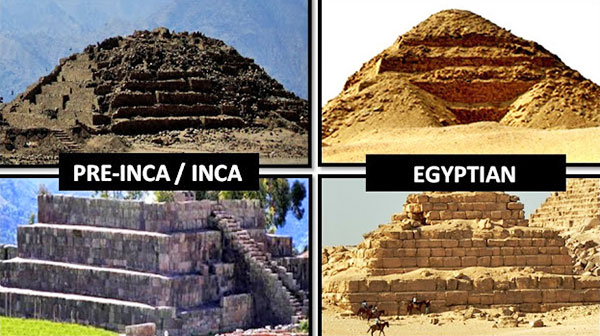
Image Credit:
Richard
Cassaro
Furthermore, many ancient civilizations structures appear incredibly
similar, if not identical.
Megalithic construction was a global phenomenon that plagued ancient
cultures around the globe, thousands of years ago. It is not
possible that cultures separated by thousands of miles decided to
erect nearly identical structures by chance.
During a certain point in our history - which by the way was poorly
documented, as we have absolutely no idea how ancient civilizations
managed to erect some of the most incredible sites on the planet -
ancient people somehow get motivated and found the necessary means
to haul around gigantic blocks of stone with a weight between 20
tons, 200 tons, and erect some of the most impressive ancient sites
on the planet.
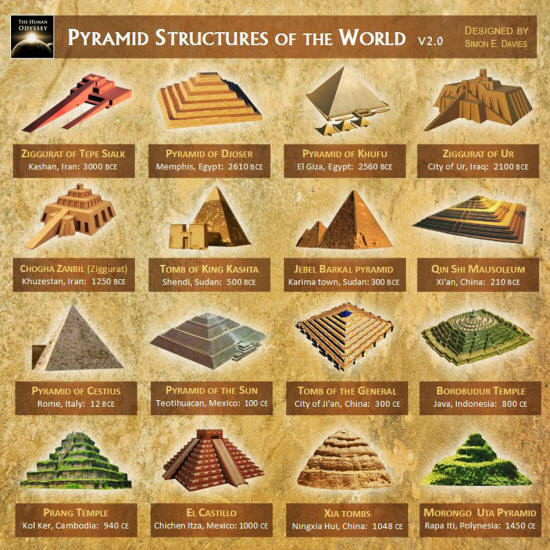
If this was an isolated event that occurred on a certain continent
it wouldn't be such a shocking thing.
But when you have the same
thing being repeated over and over again you come to realize this
megalithic phenomenon was not present in just one or two ancient
civilizations, but in nearly all ancient cultures that
existed on Earth.
This is why I ask:
-
Are the enigmatic
parallels between structures seen throughout the ancient
world truly a random, isolated event?
-
Or could they be
interconnected somehow?
-
And if they had
some kind of connection, was it important not just that the
temples were built in a similar way, but exactly how they
were erected, and the function they served?
Impossible Similarities
- Baksei Chamkrong
(Cambodia) and Temple of the Great Jaguar (Guatemala) -
by Ivan Petricevic
November 06,
2017
from
Ancient-Code Website
Two ancient temples, built by two ancient civilizations separated by
more than 9,000 miles erected two structures with uncanny
similarities that scholars have not been able to explain.
-
Did they share
the same blueprint?
-
Have you ever
asked yourself how it is possible that many ancient
structures around the globe are so similar in construction,
style, and design?
-
Hundreds of
pyramids and temples around the globe display chilling
similarities with counterparts located thousands of
kilometers away.
-
How can this
phenomenon be explained?
-
Is it just
coincidence at play?
-
Or, as many other
authors have suggested, an unconscious connection that
connects ancient civilizations around the globe?
One of the most
incredible - eerily similar - ancient temples we've ever encountered
are located in Siem Reap, Northwest Cambodia, and its counterpart -
more than 14,000 kilometers away in Guatemala.
Baksei
Chamkrong (Cambodia)

Image Credit
Just outside the magnificent ruins of Angkor Wat stands an ancient
pyramid temple known as Baksei Chamkrong.
While it is a solid rock structure, and therefore cannot be carbon
dated, mainstream archaeologists suggest that it was constructed in
the tenth century AD.
Curiously, and to the surprise of many, the name Baksei Chamkrong
means "The Bird Who Shelters Under Its Wings" and comes from an
ancient legend. In it, the king tried to flee Angkor during a siege,
and then a huge bird landed and sheltered him under its wings.
The Temple of
The Great Jaguar (Guatemala)
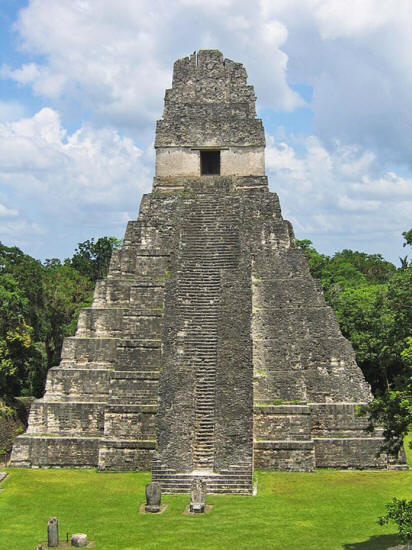
Image Credit
Located in the Petén Basin of Guatemala, lay the ruins of the
ancient
Mayan city of Tikal.
It was one of the most important
ancient cities of the Maya.
Tikal was the capital of a conquest state that became one of the
most powerful kingdoms of the ancient Maya
Amongst the long-forgotten structures at Tikal is the Temple of the
Great Jaguar, which according to experts dates back to the eighth
century AD.
Although the Cambodian pyramid is much smaller than the pyramid in
Guatemala, the similarities between the specific design features are
uncanny.
Both these ancient structures have an unusually steep slope angle
that we don't see in many other pyramids or temples. However, and
perhaps most importantly, they both feature a stepped formation.
There's a massive stairwell going up the middle of both temples, and
there's a domed area located on the top. Once there, you can see
there's a small door that goes inside the pyramid, and there's
another internal structure that looks the same.
***
Basically what you have here is an ancient civilization in Cambodia
and another one in Mesoamerica.
Despite the fact they are separated
by more than 9,000 miles - more than 14,000 kilometers - they
feature incredible similarities that no one has been able to
explain.
There are so many parallels between these two structures, it's
incredible.
It's unbelievable that scholars haven't recognized the parallels
between these two structures until recently, and noticed that there
are more structures around the globe which are also eerily similar
in design.
So we know the similarities are there, but,
-
How can these be
explained?
-
Is it possible
that both ancient civilizations were using the same
blueprint?
-
But if they,
where did that blueprint come from?
-
Is it possible
that both these seemingly unrelated sites, located thousands
of miles apart, share a common architect?
-
A common builder?
-
One that as many
authors have suggested did not originate from Earth, but
rather from the stars?
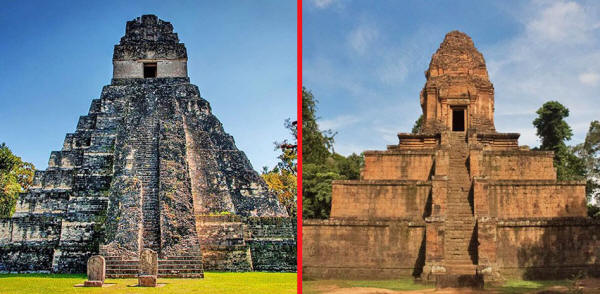
The Builder -
A star God?
Cambodian folklore ascribes the construction of Angkor to Preah
Pisnokar, a being considered of half-human, half-divine.
Preah
Pisnokar was the son of the moon goddess and a mortal man.
One day, the goddess decided to take Pisnokar to Heaven, where he
meets the great high god Indra, who determines that the boy is to be
given special education.
Once in heaven, Pisnokar was given knowledge about mathematics,
engineering, architecture, and various other scientific disciplines.
If we take a glimpse at
the Ancient Astronaut Theory, we
see there are interesting parallels that exist between the Mayan and
Cambodian civilizations and their stories.
If we take a look at the Maya manuscripts, the god Kukulkan
is responsible for the architecture and design of their pyramids and
temples.
He was also the God who gave humankind knowledge on mathematics,
engineering, and other different scientific disciplines, basically
the identical instructions attributed to Pisnokar.
Kukulkan is said to have descended from a star.
In ancient Maya mythology, Kukulkan is depicted as the feathered
serpent, but he was also seen as a big being who wore a helmet, but
not just any helmet, one with rays on it, and he was depicted
sitting on a half-open, egg-shaped 'craft.'
According to Central American mythology, he was a teacher; he was
the 'bringer of knowledge.' In other words, according to the Ancient
Astronaut Theory, he was a flesh and blood extraterrestrial.
-
But is it possible that these two 'otherworldly architects' are in
fact one the same?
-
And if so, is it possible that there is more evidence of a 'master
builder' in other parts of the world as well?
The Incredible
Similarities
...between Puma Punku's "H Blocks" and
Sudan's Pyramids
by Ivan Petricevic
November 07,
2017
from
Ancient-Code Website
Located in the desert hills of Northern Sudan we find a set of
enigmatic Pyramids that resemble their counterparts in Egypt.
However, unlike the
majestic structures erected in Egypt, the Pyramids of Sudan have
remained unnoticed for decades.
Some 200 kilometers of Sudan's Capital Khartoum we find the
mysterious
pyramids of Meroe. The site once served as the primary
residence for the rulers of the
Kush Kingdom, more famously known as
the Black Pharaohs.
In their honor, hundreds of strange pyramids were erected in Meroe
where once an ancient, long-dried river existed.
The enigmatic Pyramids of Sudan range from 5 to 30 meters in height.
According to scholars, they were built between 7120 and 300 BC and
usually face east in order to meet the rising sun.
According to scholars, the Pyramids of Meroe feature decorative
elements inspired not only by Pharaonic Egypt but by ancient Greece
and Rome as well.
This fact makes the
priceless ancient relics according to UNESCO.
The enigmatic - miniature - Pyramids of Sudan featured a rather
curious - most likely random - similarity to another ancient site
located halfway around the world:
the archaeological
complex of Puma Punku.
Puma Punku is a large
ancient temple complex that belongs to the ancient site
of Tiahuanaco in Bolivia.
According to experts, the archeological site dates back to around
536 AD.
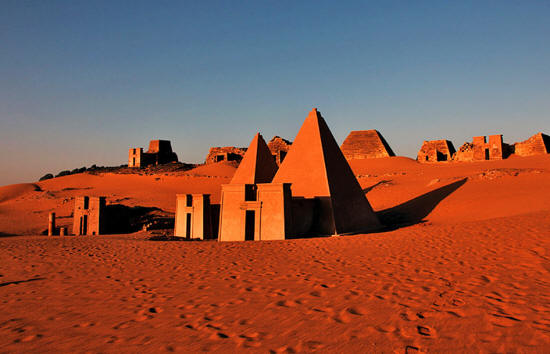
Meroe by miszka
Translated to the "The Door of the Puma," the Puma Punku complex is
made up of an unwalled western court, a central unwalled esplanade,
a terraced platform mound that is faced with stone, and a walled
eastern court.
Puma Punku featured some of the most impressive stone blocks in
South America.
The largest of the stones found at the site is 7.81 meters long,
5.17 meters wide, averages 1.07 meters thick, and is estimated to
weigh about 131 metric tons.
It still remains an enigma as to how the ancient builders of Puma
Punku - and Tiahuanaco - managed to transport these massive stones
from their quarries.
Archaeologists argue that the transport of these stones was
accomplished by the large labor force of ancient Tiwanaku.
In addition to massive stones, Puma Punku features smaller stones
which have become a major object of study, due to their incredibly
smooth surfaces, laser-like cuts, sharp corners and perfect shapes.
However, despite the fact that Puma Punku has a lot to talk about,
we focus on the curious and perhaps most notable stones of the site:
The famous H-Blocks.
The incredible H-shaped
blocks found at Puma Punku all match each other with extreme
precision and fit into each other like Lego blocks.
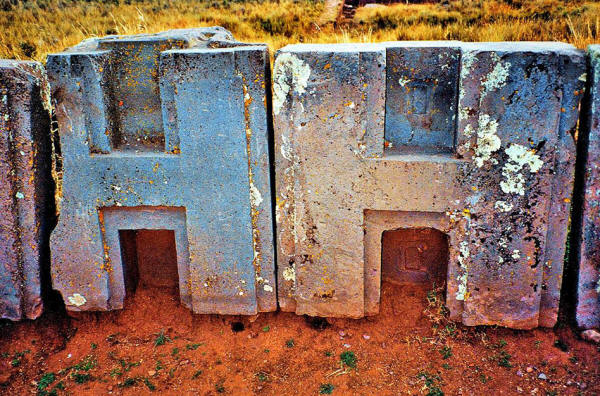
Image Credit
It is noteworthy to mention that the way the walls of Puma Punku
were assembled is outrageously beautiful.
Each stone was finely cut
to interlock with the surrounding stones allowing its blocks fit
together like a puzzle, forming load-bearing joints without the use
of mortar.
Curiously, if we compare the ancient pyramids of Sudan and their
beautifully designed entrances to the H-Blocks at Puma Punku, we
notice an uncanny similarity that cannot go unnoticed.
Whether or not there is more to both of these archaeological sites
is another story.
However, we did want to
point out that at least in terms of design, both archaeological
sites may share a small similarity.
The Incredible
Similarity
...between the Coricancha Temple in Peru
and the Valley Temple of Egypt
by Ivan Petricevic
November 09,
2017
from
Ancient-Code Website
The Coricancha (in Quechua: Quri Kancha, 'golden temple') is a
political, and religious Inca temple of the geographic center of the
city of Cuzco, in Peru.
The word Coricancha (also written as Qorikancha) is formed by the
union of two Quechua words:
According to researchers, the original name was "Intikancha", and is
related to the God Inti and the golden color of its interior,
referring to the sun.
It is not clear exactly in what year the construction of the temple
began, but it is speculated that it dates back from the period of
the Ayamarcas.
In the year 1438, when assuming power the ninth Inca, Pachacuteq,
remodeled the entire city, and later renamed the temple to
Qorikancha (which is the current name).
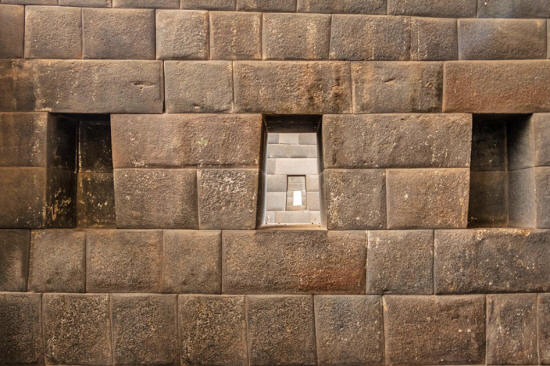
Features of the Coricancha Temple in Peru.
Image Credit: Shutterstock
According to the Inca conception, the Qorikancha was the religious,
geographic and political center of Cusco, and was so important that
Garcilaso de Vega and Cieza de León, describe it as
the temple "covered in gold":
Its floors and walls,
including the garden, had animals and plants of real size, made
of pure gold.
The temple, the
materials, and the technique are very similar to that of
Sacsaywamán
or
Machu Picchu, except that here the
Megalithic style is not so heavily presented.
Here we see an imperial
style with regular rigging in parallelepipeds; the predominant
element is the
andesite stone.
The remnants of Coricancha are considered a marvel of Incan
architecture. In fact, experts to this day are unsure as to how the
ancient Incas managed to create such perfectly shaped walls.
Modern engineers say the precision of the stonework rivals that
being produced today with advanced machining. However, the Inca
weren't the only ancient civilization to achieve such building
proficiency.
If we travel some 6,500 miles at the other side of the world,
in
Giza, Egypt, we see the same signature building
techniques at the Valley Temple next to the Sphinx.
Coincidence? I wouldn't say so. Rather the same blueprint...
Imagine for a second standing in front of
the Sphinx temple in Egypt while observing the incredible
ruins of the ancient temple. Then - imagine - you close your eyes
and when you open then, you end up at the Coricancha temple in
Cusco.
The styles are so similar
that if you did not know where you were standing at a precise
moment, you couldn't tell the difference between the two, due to the
fact that the building styles of those two temples are eerily
similar.
The similarities between the two temples tell a story that most of
us have failed to hear.
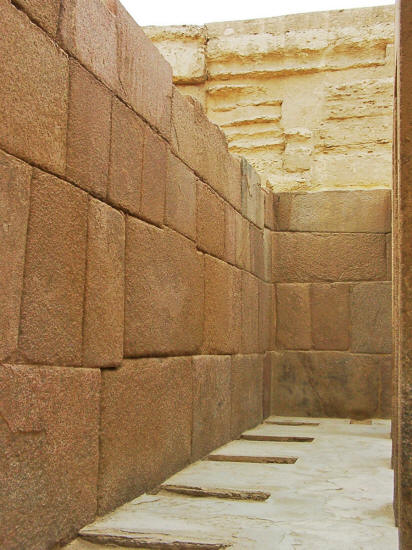
Khafre valley statue sockets.
Image
Credit: Wikimedia Commons
Both temples feature incredible blocks fitted together so tightly
that you cannot fit a single sheet of paper in between them.
However, as noted by many
researchers and authors, what makes these temples even more
fascinating is the size of the stones used in their construction.
In fact, some of these blocks are so large that even engineers today
would struggle to put them into position. The limestone blocks at
the Valley Temple are estimated to weigh around 200 tons each.
Somehow, the ancient builders managed to lift these massive stones
and place them with incredible precision to heights of around 40
above the ground, or the height of a four-story building.
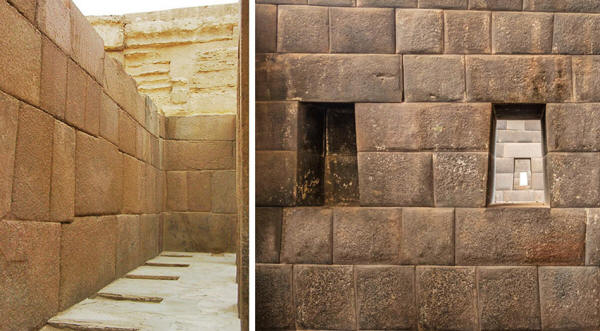
Interestingly, this was not merely accomplished at these two sites.
There is ample evidence
of similar sites around the globe.
***
Across the globe, ancient cultures chose repeatedly, to build
similar awe-inspiring blocks fitted together with such a precision
that modern-day engineers are left awestruck, and all of that using
super-massive stones and most important, without the use of mortar.
|













